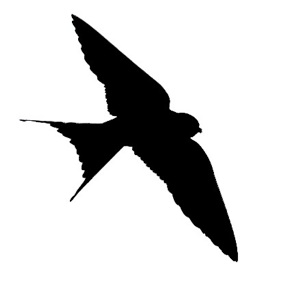A practical guide to bird watching in Sonoma County, California
(Unless otherwise indicated, all phone numbers are in the 707 area code)
A practical guide to bird watching in Sonoma County, California
(Unless otherwise indicated, all phone numbers are in the 707 area code)


A common swallow during spring migration and the summer months. Breeds widely in Sonoma County. Look for nesting colonies in the spring under bridges or other suitable cliff-like locations, including building eaves, bridges, dams, culverts, piers, and large rocks--anywhere there is a vertical face protected by an overhang of some kind (it now appears to be fairly uncommon for these swallows to use actual cliffs because suitable man-made surfaces abound). Cliff Swallows make pot- or gourd-shaped nests from mud they collect from pond or stream banks, flooded fields, or puddles. Cliff Swallows begin to show up in Sonoma County in mid- to late March. The bulk of the breeding population is present by mid-April. By the end of September, the birds are virtually gone, having headed south to winter in South America.
Fairly easy to identify when seen sitting on or in a nest, which allows a good view of the distinctively patterned face. Look for the dark blue-black cap, the deep rufous cheek and throat, and the white to buff brow (sometimes referred to as a “headlight”). The upper breast is buff, the belly and flanks white. There is usually some black at the lower edge of the throat. The buff at the upper breast extends up and over the back of the neck to create a buff band separating the rufous nape and dark crown from the dark back and wings. Whitish stippling on the back is difficult to see in the field. Buff also at the rump. The color of the pale brow shows considerable geographic variability. The birds we commonly see have a very pale buff to white brow, as in the bird pictured above (the bird in flight below, photographed in Texas, has a cinnamon brow). Juveniles lack the pale brow, having a uniformly dark head and throat. Underwing in flight is plainest of the swallows we see locally.
Identifying a Cliff Swallow (or any swallow) in flight is more challenging. The birds fly quickly and erratically, making it hard to see details of plumage. Having said that, Cliff Swallows often can be picked out easily from among other swallows by their conspicuously buff-colored rumps. The “headlight” may also be apparent at close quarters. The buff rump, pale brow, rufous cheek and throat, and a squarish tail (when closed) together indicate Cliff Swallow. Barn Swallow (Hirundo rustica) is similarly colored, but it has the classic, split swallowtail (compare flight silhouettes at the bottom of this page) and lacks the buff rump and pale brow. Cave Swallow (Pterochelidon fulva) is quite similar in appearance to CLiff Swallow but does not occur in Sonoma County (normally confined to south-central Texas).
English synonyms: American Cliff Swallow, American Cliff-swallow, Crescent Swallow, Eave Swallow, North American Cliff-Swallow, Republican Swallow, Rocky Mountain Swallow
Cliff Swallow in other languages--German: Fahlstirnschwalbe; Spanish: Golondrina Alfarera, Golondrina de alcantarilla, Golondrina de Farallón, Golondrina de las Rocas, Golondrina de Peñasco, Golondrina Gorginegra, Golondrina grande, Golondrina rabadilla canel, Golondrina rabadilla canela, Golondrina Rabadilla Parda, Golondrina Risquera; French: Hirondelle à front blanc; Russian: американская горная ласточка, Белолобая горная ласточка, Белолобая ласточка, Ласточка белолобая; Japanese: サンショクツバメ(Sanshokutsubame); Chinese: 美洲燕
(Language information from Avibase, Birds of Europe (Mullarney et al, Princeton Field Guide Series), and Birds of Asia (Mark Brazil, Princeton Field Guide Series).
Further reading:
Bolander and Parmeter, Birds of Sonoma County California, rev. ed., 2000, p. 90
Brinkley, National Wildlife Federation Field Guide to Birds of North America, 2007, p. 291
Burridge, ed., Sonoma County Breeding Bird Atlas, 1995, p. 110
Dunn and Alderfer, eds., National Geographic Field Guide to the Birds of North America, 5th ed., 2006, p. 332
Dunn and Alderfer, eds., National Geographic Field Guide to the Birds of North America, 6th ed., 2011, p. 372
Dunne, Pete Dunne’s Essential Field Guide Companion, 2006, pp. 459-460
Ehrlich, Dobkin, and Wheye, The Birder's Handbook, paperback edition, 1988, p. 402
Fix and Bezener, Birds of Northern California, 2000, p. 274
Floyd, Smithsonian Field Guide to the Birds of North America, 2008, p. 326
Kaufman, Field Guide to Birds of North America, 2000, p. 232
Kaufman, Field Guide to Advanced Birding, 2011, pp. 96, 389
Lukas, Bay Area Birds: From Sonoma County to Monterey Bay, 2012, pp. 202-203
Parmeter and Wight, Birds of Sonoma County California, Update (2000-2010), 2012, p. 53
Peterson, Birds of Eastern and Central North America, 5th ed., 2002, p. 232
Peterson, Field Guide to Birds of Western North America, 4th ed., 2010, p. 270
Peterson, Western Birds, 3rd ed., 1990, p. 250
Sibley, Field Guide to Birds of Western North America,1st ed., 2003, p. 315
Stokes, Stokes Field Guide to the Birds of North America, 1st ed., 2010, p. 517
Vuilleumier, American Museum of Natural History, Birds of North America: Western Region, 2011, p. 296
Voice: Cornell Lab of Ornithology: All About Birds--Cliff Swallow
© Colin Talcroft, 2009, 2010, 2011, 2012, 2013, 2014
Unless noted, all photos by the author. If you would like to use one of my images, please ask for permission for non-commercial use with proper credit or commercial use with proper compensation.
Cliff Swallow
Petrochelidon pyrrhonota
Cliff Swallow in flight, Texas, June 19, 2013
1990-2013 Sonoma County data. Graph provided by eBird (www.ebird.org), generated November 11, 2013
EBird reported occurrence in Sonoma County


Cliff Swallow nests, Sebastopol, May 19, 2011

Cliff Swallow, Sebastopol, May 19, 2011



Cliff Swallow flight silhouette
Barn Swallow flight silhouette